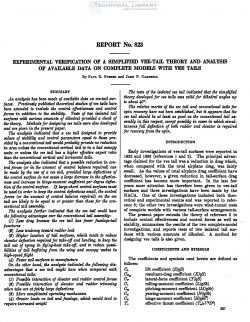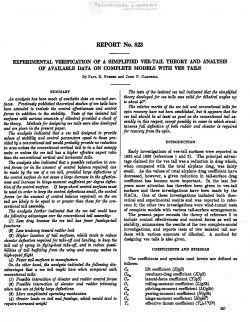naca-report-823

- Version
- 327 Downloads
- 1.53 MB File Size
- 1 File Count
- August 31, 2016 Create Date
- August 31, 2016 Last Updated
National Advisory Committee for Aeronautics, Report - Experimental Verification of a Simplified Vee Tail Theory and Analysis of Available Data on Complete Models with Vee Tails

An analysis has been made of available data on see-tail sur-
faces. Previously published theoretical studies of see tails have
been attended to include the control efecticeness and control '
forces in addition to the stability. Tests of two isolated tail
surfaces with various amounts of dihedral provided a check of
the theory. Methods for designing see tails were also developed
and are given in the present paper.
The analysis indicated that a tee tail designed to provide
values of stability and control parameters equal to those pro-
vided by a conventional tail would probably provide no reduction
in area unless the conventional certical tail is in a bad canopy
wake or unless the tee tail has a higher efl'ectiee aspect ratio
than the conventional vertical and horizontal tails.
The analysis also indicated that a possible reduction in con-
trol forces (or in the amount of control balance required) can
be made by the use of a see tail, provided large deflections of
the control surface do not cause a large decrease in the (festive-
ness and increase in hinge-moment coeflicient per degree deflec—
tion of the control surface. If large-chord control sulfaces must
be used in order to keep the control deflections small, the control
forces (or the amount of control balance reguired) on the see
tail are likely to be equal to or greater than those for the con-
ventional tail assembly.
The tests of the isolated vee tail indicated that the simplified
theory developed for sea tails was valid for dihedral angles up
to about 40°.
The relative merits of the see tail and conventional tails for.
spin recovery have not been established, but it appears that the
res tail should be at least as good as the conventional tail as-
sembly in this respect, except possibly in cases in which simul-
taneous full deflection of both rudder and elevator is reguired
for recovery from the spin.
| File | Action |
|---|---|
| naca-report-823 Experimental Verification of a Simplified Vee Tail Theory and Analysis of Available Data on Complete Models with Vee Tails.pdf | Download |
Comment On This Post